Death From Above! A Review of SMG’s Reproduction FG-42 Rifle

Author shooting one of SMG's reproduction FG-42 rifles
One of the most interesting firearms to come out of World War II is the Fallschirmjaegergewehr 42 – the FG-42. There are so few of them still in existence that they often don’t get the attention they should, but that will all change now. SMG Guns of Decatur, Texas is building new semiauto-only replicas of the second model FG-42, and we got our hands on one to test out.
The FG42 had its genesis in the disastrous German airborne assault on Crete in May 1941. German paratroops (fallschirmjaeger) jumped with only light weapons (pistols and submachine guns), while their heavier arms were dropped in separate weapons canisters. On Crete many troops were separated from their weapons in the drop, and were left effectively unarmed, to unpleasant ends. The Luftwaffe decided in the aftermath to look for a new rifle which could fill the role of the Mauser and the MG34, and which could be carried in hand by paratroops during a jump.
The requirements set out for this new rifle were quite stringent. It had to be chambered for the standard 8×57 cartridge (the Wehrmacht was developing the 8mm Kurz at this time, but the Luftwaffe insisted on the full size rifle round for maximum firepower), and it had to use detachable box magazines. It had to be no longer, heavier, or bulkier than the K98k bolt action rifle, and it had to be capable of closed bolt fire in semiauto and open bolt fire in full auto. Two firms, Rheinmetall and Kreighoff, produced prototypes and the Rheinmetall one was chosen for development.
The result of this development program was the Type E, or first model, FG-42 rifle. This rifle met the design requirements, but was right on the narrow edge of practicality. Many components were too fragile, as weight had been savagely cut wherever possible to meet the strict weight limit imposed on the design. The buttstocks were made of stamped aluminum and prone to damage, the bipod legs were too thin, and the gas piston port was located midway along the barrel to allow for a short and light gas piston. This required the designer (Louis Stange) to use a clever design element to keep the gun safe, as gas pressure was really too high for a proper design. Moving the gas port forward to reduce pressure would make it too heavy, and reducing the size of the gas port would make the gun unreliable. Instead, he cut the chamber in the barrel to be cylindrical instead of tapered, so that while gas pressure was very high during the initial bit of extraction, the case would be blown out to fit the cylindrical chamber and retain a gas seal. This extra bit of time having the chamber sealed during extraction was enough to allow the pressure to drop to a safe level before the gas seal was lost and the case fully extracted.
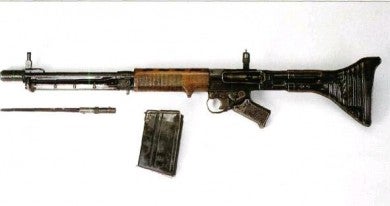
Original German Type E FG-42
Anyway, about 2000 of these early FG42s were built before the design was modified to address its problems. The second model (Type G) was a heavier and more robust gun. The bipod pivot was moved to the muzzle for better stability, the buttstock was made of wood, dust cover doors were added to the magazine well, and the receiver was redesigned as a stamping instead of being milled. The second model rifles were more successful, and their increased weight also made full-auto fire more controllable. About six thousand were made before the end of the war, and today they are one of the most valuable WWII firearms in the US, with prices in excess of $100,000. That puts them well out of reach of almost everyone – but now there is an alternative.
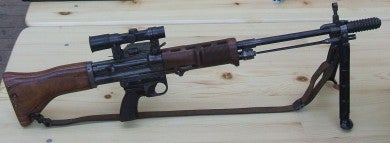
Original German Type G FG-42
SMG’s Reproduction
SMG Guns is building a fully functional reproduction of the second model FG-42 in Texas. It does not use any original parts (there are virtually no originals available), and everything is being made from scratch on modern CNC machines and with modern high-quality steels (German wartime production often had to make do with whatever was available). When SMG offered to send me one to try out, I jumped at the opportunity – I wanted to see how it would compare to the originals, and what it would be like to shoot.
The Rifle’s Arrival
After a few days, I got a text message from our dealer, announcing that the Glider Corps had just dropped off a rifle, and I jumped in the truck go pick it up. As a guy used to buying well-used old relics, it was really a treat to crack open this gun case and find a pristine new rifle. It had a glistening finish, and the wood had a beautiful grain to it. Along with the rifle was a brand new reproduction sling made to original spec, a pair of 20-round magazines, an instructional video detailing a few quirks of the design, and a translation of the original German manual, modified to match the details of this semiauto. After prying it from the hands of my dealer, I took it back home to disassemble.
Internals
I can’t help it, the first thing I want to do with an interesting new gun is take it apart and see how it works – and this this FG-42 was certainly no exception. I have had the opportunity to disassemble an originalGerman second model rifle, so I was curious how much different SMG’s semiauto would be.
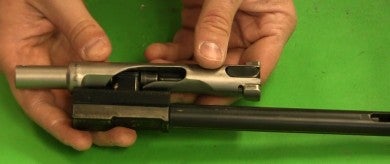
Bolt, firing pin, and piston from SMG’s rifle
As it turns out, there are enough differences that original parts will not interchange with the new rifles, but the operating principles are all the same (with the exception of the new ATF-approved semiauto trigger mechanism). The FG-42 had a rather unusual method of operating, based on the Lewis gun and later acting as the starting point for the US M60 machine gun. The firing pin is held rigidly by the gas piston, and travels back and forth inside the bolt (which rotates to lock, with two opposing lugs). A cammed track in the bolt body forces it to rotate and lock as the gas piston moves forward under spring pressure, and the trigger mechanism catches the piston and stops it from moving fully forward until the trigger is pulled. At that point, a second spring inside to bolt provides the force to push the piston (and with it, the firing pin) the last bit forward, so the firing pin emerges from the bolt face and fires the cartridge.
This system is authentically copied from the original German design, quirks and all. For the shooter, it is interesting to note that this mechanism creates an unusual feel to charging the rifle. The first bit of travel when pulling back the charging handle is quite stiff, as it first compresses the spring inside the bolt, then rotates the bolt open, and only then is free to move backwards under pressure from the mainspring.
The trigger mechanism is, of course, different from the original per ATF requirement, but it works on the same principle, just with a semiauto disconnector and no capacity for open-bolt firing. The flat spring used to hold the pistol grip on the gun (which will also be recognizable to those who have used an M60) has been inverted by SMG, so that it must be rotated up for removal. The originals rotated down, which lends itself much more easily to accidental disassembly in use. The safety has a 90 degree throw unlike the original’s 180, and the semi/full selector lever has been omitted.
On The Range
It took some deliberate effort to not handle this rifle with kid gloves, because I am so used to knowing them only as astronomically expensive originals. But SMG had urged me not to baby it at all, and this gun can stand toe-to-toe with anything else on the range. That’s what I like so much about this sort of very high-quality reproduction – you can appreciate it for the original design and its place in history, but you can also take it out to the range and blaze away to your heart’s content.
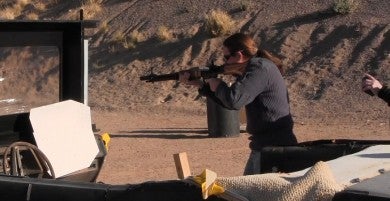
Author blazing away with the FG-42 at a 3-Gun match
Anyway, I have a stash of Romanian 8mm ammo, which is pretty reliable stuff, although steel-cased, lacquered, and corrosive. Well, he said not to baby it, right?
I’m left handed, but started out shooting right handed instead, out of concern for spent cases. The receiver of the FG-42 is surprisingly short, because the side-mounted magazine is located directly above the trigger mechanism, instead of forward like most rifles. There is a brass deflector behind the ejection port, but the rifle is clearly intended for right-hand firing. After watching where the cases went, it because apparent that shooting lefty would not get me a spent case in the nose, so I switched to my natural stance.
I started by shooting at steel plates (from 4″ to 12″ in diameter) at 100 yards, both offhand and prone. These presented no problem at all to hit, and the 8mm slugs made a nice authoritative clang with each hit. Firing offhand is the more challenging stance, of course, but the aperture sight on the FG-42 was pretty effective. When I went prone, hits were downright easy to make over and over.
The rifle is relatively heavy, at about 12.5 pounds, but pretty well balanced. It uses an aperture sight mounted towards the rear of the receiver, and elevated high enough to allow a good cheek weld. I was able to hit my larger (10″ and 12″) steel plates fairly consistently offhand, which is about as good as my shooting gets with any iron sights. I also took it to a local 3-gun match, where the minimal muzzle climb helped me put close-range shots on target much more quickly than my M1 Garand can.
Recoil
From a shooter’s perspective, one of the really outstanding characteristics of the FG-42 is its felt recoil. Rick at SMG says it is comparable to an AK in 7.62×39, and he is not exaggerating. Despite shooting full-power military 7.92x57mm ammunition, this rifle was the gentlest thing I’ve shot in any caliber bigger than 5.56mm. There are several factors that allow this to happen:
- Muzzle brake. The FG-42 has a very effective muzzle brake. It makes an awful lot of concussion for bystanders, but is great for the shooter.
- Weight. Yep, weighing in at 12.5 pounds certainly helps tame recoil.
- Inline design. Like the ubiquitous AR, the FG42 uses an inline design, where the line of the bore runs straight through the center of the stock. This helps the shooter control recoil and prevent muzzle climb.
- Stock buffer. This is the big one, I think. The buffer in the FG42 stock allows the entire action to recoil about a quarter inch into the buttstock. This helps absorb an awful lot of recoil impulse and makes for a very comfortable gun.
I fired about 250 rounds in a couple hours, and had absolutely no discomfort at all. Most guns don’t actually hurt, but you know it after a range session like that, particularly with a potent rifle cartridge like 8×57. The FG42 did noting of the sort, even firing prone off the bipod. At the same time, muzzle rise was equally surprising for its absence. As long as you aren’t leaning back away from the gun when you shoot, the muzzle just doesn’t move. Looking at slow-motion footage of my shooting, you can see the action recoiling into the stock, and the push against my shoulder, but the muzzle just stays locked in place.
Magazines
Original FG42 magazines are, not surprisingly, as rare as the proverbial hens’ teeth. To make matters worse, the two models of original FG-42 didn’t use the same magazines (I have no idea why not; I haven’t seen suggestions that the first model magazines had any particular problems). Rather than reproduce magazines from scratch, SMG built their reproduction to use Czech ZB26/30 light machine gun magazines. The ZB magazines are the perfect choice for the FG-42, as they look very similar and are high quality and relatively easily available. They hold 20 rounds, same as the original mags. SMG provides two of these mags with each rifle, both being numbered to the gun and test fired prior to shipping out.
Historical Authenticity
Aside from the magazines and trigger mechanism as mentioned above, there are a couple other differences between SMG’s rifle and the originals. The main one is the receiver, which SMG has milled from a block of steel. This is how the first model German guns were made, but the second model (which is what SMG has recreated) was originally made with a stamped receiver. The Germans at the time had advanced metal stamping skills, and a stamped receiver was cheaper for mass production as well as lighter weight. SMG, however, is making these in small numbers on modern CNC machinery and a milled receiver is by far the more practical method for them. This does mean some differences in appearance, such as the case deflector being an integral piece instead of riveted on, and the absence of rivets to attach the receiver to the front trunnion block (which is already an integral part of the milled receiver). The grip assembly is also milled, instead of being stamped, and there are a few other minor differences that will only be apparent to the serious student of FG-42 rifles.
Accuracy
I don’t have a bench at my range, so my accuracy testing was done from the 300 yard line, off the rifle’s integral bipod. I was shooting at an ad-hoc silhouette target with decent contrast, still using the Romanian milsurp ammo. I set the rear sight to its 300 meter mark, and found that it shot about 12 inches high overall (I believe the sights are calibrated for German 198gr ball, while my Romanian was 150gr). After adjusting my point of aim to the bottom of the silhouette, I was able to put 8 of 10 rounds into the paper, which I’m pretty happy with (they were all in the upper left quadrant of the target). It’s not really a test of the rifle’s accuracy potential, but I’m more interested in what results I can achieve in a practical test. It is worth noting that for folks interested in precision shooting with an FG42, these new rifles all have an integrated dovetail mount that will fit both original and reproduction ZF41 telescopic sights. Very few FG-42s were actually issued with scopes during the war, but the make a very cool accessory for getting the most out of one of these reproductions.
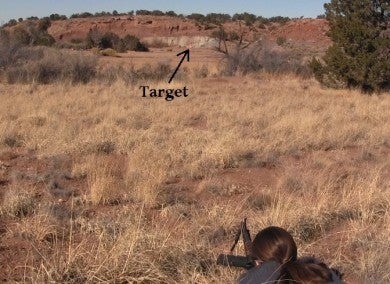
Shooting the FG-42 from the 300 yard line
Reliability
Over the course of my firing, I did have several malfunctions. One was simply user error – don’t try to rack the bolt with the safety on, or you’ll jam the gun up. The malfunctions that weren’t my fault were several failures to extract. They occurred sporadically through my shooting, and I had no other problems from the gun otherwise. What happened was that the extractor claw didn’t fully snap over the cartridge rims, and thus didn’t pull them out after firing. The cases cases were easily removed by hand, and did not have torn rims. Rick Smith at SMG suggested that my Romanian surplus ammo probably had rims thicker than commercial spec, and I grabbed a set of calipers and checked my Romanian ammo against Remington, Winchester, and Federal brass based cartridges. The surplus rims measured 0.047-0.051 inches, while the commercial ammo was thinner and more consistent, at 0.040-0.041 inches. That means the surplus ammo I used had rims 25% thicker than spec – I’m actually a bit surprised I didn’t have more problems.
The rifle exhibits excellent ejection through all of my shooting – it threw cases very consistently about 4 feet to the right and slightly forward of the gun. I find this consistency to be a good indicator of a well-tuned mechanism, and it certainly made brass cleanup easy.
Workmanship
The workmanship is excellent on the rifle – it is a credit to SMG’s exacting manufacturing standards. The wooden stock and handguard look outstanding, as does the finish on the metal components. The rifle comes with an excellent reproduction leather sling as well.
One of the simple ways to get an idea of a manufacturer’s standard of quality is to simply run the bolt or slide of a gun. The best feel like they are running on oiled glass – a Sig P210 is a great reference. The not so great feel rough, gritty, or otherwise flawed. The bolt on the SMG FG-42 was excellent. The bolt is surprisingly stiff for its first bit of travel because of the mechanical design (the first half inch or so of travel has to compress the heavy firing pin spring as well as unlock the bolt), and then it slides the rest of the way nice and smooth.
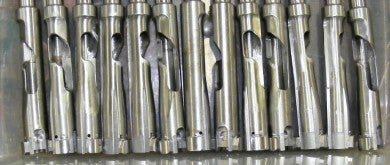
A batch of bolts in production for SMG’s FG-42 rifles
My only complaint in this area was that the handguard on the rifle began to crack at the front after a few hundred rounds. The original German FG-42 rifles had a piece of corrugated sheet metal pressed into the circumference of the handguard to prevent this, and that metal is not present in SMG’s guns. Adding that feature or perhaps giving a slight clearance between the handguard and barrel surface would solve this problem, and I have no doubt that SMG will address this in future production (my review gun was serial number 14).
Price and Availability
Yeah, you knew this part was coming. The price on these rifles is $4995, and according to Rick at SMG there is currently a 6-9 month wait time for them. This isn’t vaporware, though – the guns are actively in production and the wait time is because of the number of people already on the waiting list. Getting your name on that list requires simply a call to SMG, and a $100 non-refundable deposit.
Considering the amount of time and research that went into these reproductions, I think they are a bargain. The rifle is as enjoyable to shoot as anything else I’ve handled (and better than most) on top of its historical significance. I don’t think I could ask for much more. Certainly the price will place it out of reach of many folks, but it’s simply a fact of life that really nice things are expensive. Some people as well will not be interested because of the places where it does stray from the original FG-42 design, but such is life. Those folks are quite welcome to bid on the next original one that comes up at auction. As for me, I will happily save up my pennies for one of these outstanding rifles from SMG.

SMG’s reproduction FG-42
